ICSE Class 10 History and Civics Question Paper 2024 with Answer Key is available for download here. ICSE Class 10 History and Civics Exam was conducted on February 26, 2024, from 11 AM to 1 PM. As per the students, the exam difficulty level was reported to be moderate.
ICSE Class 10 History and Civics Question Paper 2024 with Answer Key
| ICSE Class 10 History and Civics Question Paper 2024 with Answer Key | Check Solutions |
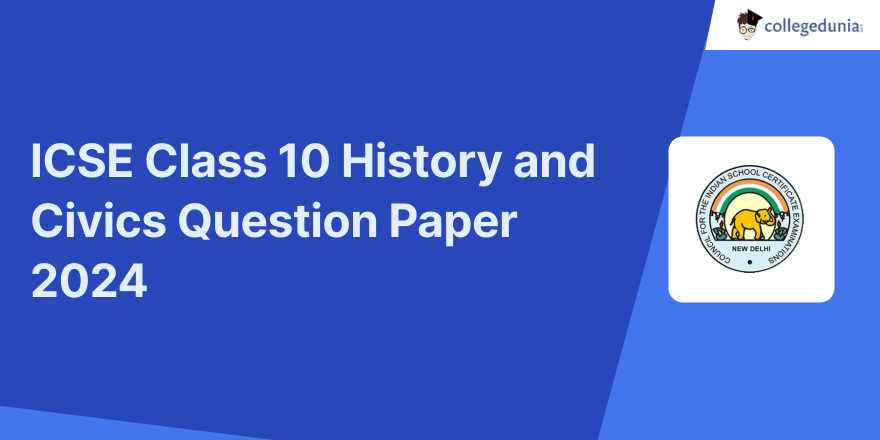
Question 1
Question i:
The salaries and allowances of the ministers are decided by the:
View Solution
As per Article 75(6) of the Indian Constitution, the salaries and allowances of Ministers are determined by the Parliament. The salaries are specified by law, and until Parliament makes such a law, they are decided by the President.
The Parliament enacts laws to regulate the salaries and allowances of Ministers, ensuring proper financial governance and transparency. The Finance Minister or the Prime Minister does not have the sole authority to decide this matter. Quick Tip: The salaries and allowances of Ministers in India are determined by the Parliament through legislation. Understanding constitutional provisions is crucial for governance-related exams.
Civil Cases : Court of District Judge :: Criminal Cases :
View Solution
In the Indian judicial system, civil cases at the district level are handled by the Court of the District Judge. Similarly, for criminal cases, the equivalent court is the Sessions Court.
The Sessions Court is responsible for hearing serious criminal offenses such as murder, robbery, and assault. It has the authority to impose severe punishments, including life imprisonment or the death penalty, depending on the case.
The other options are not applicable:
- Revenue Court deals with land revenue matters.
- Family Court handles family disputes, including divorce and child custody.
- Commissioner’s Court is an administrative body rather than a criminal court.
Quick Tip: The District Judge oversees civil cases, while the Sessions Court is the highest court at the district level for criminal matters.
The Lok Adalat has many advantages. Which of the following statements about the advantages of the Lok Adalat is best described in the picture given above?

View Solution
The given image visually represents a conflict resolution process where two individuals initially appear to be in dispute but later shake hands in agreement. This aligns with the core principle of Lok Adalat, which functions on the spirit of compromise and mutual settlement.
Lok Adalats promote alternative dispute resolution by allowing both parties to reach a fair and amicable settlement outside the formal court system. This helps in reducing legal conflicts and fostering peaceful resolutions.
The other options, while true about Lok Adalats, do not directly describe the essence of the image:
- Inexpensiveness (A) is a feature of Lok Adalats but not visually depicted.
- Widespread organization (B) does not relate to the picture.
- Reducing court burden (D) is an effect but not the primary message of the image. Quick Tip: Lok Adalats focus on resolving disputes through mutual agreement and compromise, providing an effective alternative to lengthy court proceedings.
Given below are details of Indian citizens. Select the ones who are eligible for appointment as a High Court Judge:

View Solution
As per Article 217(2) of the Indian Constitution, a person is eligible for appointment as a High Court Judge if they:
1. Have held a judicial office in India for at least 10 years, or
2. Have been an advocate in a High Court for at least 10 years.
- Candidate Q has been a High Court Advocate for 10 years, making them eligible.
- Candidate S has held a judicial office for at least 10 years, fulfilling the second eligibility condition.
The other candidates do not qualify:
- P is a distinguished jurist, but this is a criterion for Supreme Court judges, not High Court judges.
- R has only 5 years of experience as an advocate, which does not meet the requirement. Quick Tip: To be eligible for appointment as a High Court Judge, a person must have either 10 years of High Court advocacy experience or 10 years in a judicial office.
The strength of the house is 550. On a particular day, 50 members are present. The speaker decides to adjourn the house. Identify the MOST LIKELY reason for the adjournment.
View Solution
As per Article 100(3) of the Indian Constitution, the quorum required to conduct a sitting of either House of Parliament is one-tenth of the total strength of the House.
- The total strength of the House is 550.
- The required quorum would be \(\frac{1}{10} \times 550 = 55\) members.
- Since only 50 members are present, the required quorum is not met.
The Speaker, in such a case, has the authority to adjourn the House due to lack of quorum.
Other options are incorrect because:
- Disorder in the house (A) could be a reason for adjournment, but the question specifies the low attendance.
- Breach of privilege (C) refers to violations of the privileges of MPs or Parliament, which is not relevant here.
- Contempt of the House (D) is a serious offense but is unrelated to the issue of quorum. Quick Tip: For any parliamentary session to proceed, at least \textbf{one-tenth} of the total members must be present to meet the quorum requirement.
During a hung assembly when no party gets the majority, the President appoints the Prime Minister. What power is the President exercising?
View Solution
In the case of a hung assembly, where no single party secures a majority, the President exercises their discretionary power to appoint the Prime Minister. Under normal circumstances, the President acts on the advice of the Council of Ministers. However, when no clear majority exists, they can use discretion to invite the leader most likely to form a stable government.
Other options are incorrect:
- Legislative Power (A): The President does not make laws in this context.
- Executive Power (B): The President exercises executive functions but, in this case, discretion is the primary factor.
- Judicial Power (D): The President does not perform a judicial function here. Quick Tip: When no party gets a majority in the Lok Sabha, the President exercises \textbf{discretionary power} to appoint a leader who can form a government.
Read the two statements given below and select the option that shows the correct relationship between (A) and (R):
Assertion (A): Forward Bloc had the objective of abolishing Zamindari System.
Reason (R): Subhash Chandra Bose wanted to establish a socialist state.
View Solution
The Forward Bloc was founded by Subhash Chandra Bose in 1939 as a faction of the Indian National Congress. One of its objectives was to abolish the Zamindari system, as it aligned with socialist economic reforms.
However, the Reason (R) is incorrect because while Bose aimed for an anti-imperialist and socialist-oriented policy, his primary focus was on securing India’s independence. Establishing a socialist state was not the primary reason for Forward Bloc’s formation. Quick Tip: Assertion-based questions require careful analysis. Even if both statements seem true, their relationship must be logically connected.
The ________ aimed to introduce equality between British and Indian Judges.
View Solution
The Ilbert Bill (1883) was introduced by Lord Ripon to allow Indian judges to try British and European offenders in India. This was a significant move towards judicial equality between British and Indian judges. However, it faced strong opposition from the British community in India, leading to a diluted version of the bill.
Other options are incorrect:
- Vernacular Press Act (A): Aimed to suppress freedom of the Indian press.
- Gagging Act (B): Introduced censorship laws.
- Indian Universities Act (C): Related to education reforms. Quick Tip: The Ilbert Bill was a landmark legal reform that attempted to bring equality in the colonial judicial system, though it was later weakened due to European protests.
The Rowlatt Act was called the Black Act because the Indians:
View Solution
The Rowlatt Act (1919) was termed the Black Act because it allowed the British government to arrest individuals without trial or warrant, violating basic civil liberties. This act led to widespread protests, culminating in the infamous Jallianwala Bagh Massacre.
Other options are incorrect:
- Option (A): The Arms Act (1878) restricted Indians from possessing arms, not the Rowlatt Act.
- Option (B): Trade restrictions were imposed by other colonial economic policies, not this act.
- Option (D): Indians were not forcibly sent overseas due to this law. Quick Tip: The Rowlatt Act empowered the British to detain people without trial, leading to severe public outrage and Gandhi’s first mass movement.
Who organised the Grand Delhi Durbar?
View Solution
The Grand Delhi Durbar of 1877 was organised by Lord Lytton to proclaim Queen Victoria as the Empress of India. This event was part of British efforts to establish symbolic authority over India.
Other options are incorrect:
- Lord Curzon (A): Organised the 1903 Delhi Durbar to commemorate the coronation of King Edward VII.
- Lord Canning (B): Was the first Viceroy of India and introduced the Doctrine of Lapse.
- Lord Dalhousie (D): Played a role in annexation policies but was not associated with any Delhi Durbar. Quick Tip: The \textbf{Grand Delhi Durbar} of 1877 was a British imperial event where Queen Victoria was declared the Empress of India by Lord Lytton.
Tina is inspired by the methods of the Early Nationalists and wants to follow them. She notices that the road leading to her school is damaged and has many potholes. Which of the following methods is she MOST LIKELY to follow, to solve this problem?
View Solution
The Early Nationalists (Moderates) in India followed constitutional methods such as petitions, debates, and appeals to authorities to bring about reforms. Writing a petition to the authorities regarding a civic issue aligns with their approach.
Other options involve more radical methods:
- Boycott (A): More characteristic of the later extremist phase.
- Protest (B): While peaceful, it was not the primary method of early nationalists.
- Blocking the road (D): Considered an aggressive measure, not part of their approach. Quick Tip: The Early Nationalists believed in achieving their objectives through \textbf{constitutional means} such as petitions, resolutions, and discussions.
Given below are the objectives of the Indian National Army. Identify the odd one out of the following:
View Solution
The Indian National Army (INA), led by Subhash Chandra Bose, aimed at achieving India’s independence through armed struggle. The key objectives of the INA included:
- Establishing a Provisional Government of Free India (Option A).
- Mobilising manpower and resources for military efforts (Option B).
- Instilling the spirit of Unity, Faith, and Sacrifice among its soldiers (Option C).
However, Option D is incorrect because the INA was a military organization, not a political movement meant for public opinion formation. Quick Tip: The INA aimed at securing India’s independence through armed struggle, unlike the Congress, which focused on mobilizing public opinion.
Tahir is preparing to give a speech about the Sati system in India. Which of the following Indian leader’s contribution MUST he mention in his speech?
View Solution
Raja Rammohan Roy is known as the pioneer of social reforms in India. He played a crucial role in the abolition of the Sati system by petitioning the British government, which led to the passing of the Regulation XVII of 1829, banning Sati.
Other options are incorrect:
- W. C. Bonerjee (B): A political leader, but not linked to Sati abolition.
- Bipin Chandra Pal (C): Associated with extremist nationalism, not social reforms.
- Jyotiba Phule (D): A social reformer who worked for the upliftment of lower castes, but not specifically for Sati abolition. Quick Tip: Raja Rammohan Roy is called the \textbf{Father of Modern India} for his efforts in social reforms, particularly the abolition of Sati.
Which of the following is NOT a consequence of the Second World War?
View Solution
The Second World War had several major consequences, including:
- The defeat of the Axis Powers (Germany, Italy, Japan) (Option B).
- The emergence of the Cold War between the USA and USSR (Option C).
- The formation of the United Nations (UN) in 1945 to prevent future conflicts (Option D).
However, Austria and Hungary became separate states after World War I, not World War II, making Option A incorrect. Quick Tip: World War II led to the Cold War, the formation of the UN, and the defeat of the Axis powers, but Austria-Hungary had already separated after World War I.
Identify the principle of Panchsheel.
View Solution
The Panchsheel Agreement was signed between India and China in 1954, outlining five principles of peaceful coexistence:
1. Mutual respect for each other’s sovereignty and territorial integrity.
2. Mutual non-aggression.
3. Non-interference in each other’s internal affairs.
4. Equality and mutual benefit.
5. Peaceful coexistence.
Thus, Option A correctly represents one of the Panchsheel principles. Quick Tip: The \textbf{Panchsheel Agreement} formed the basis of India's foreign policy, emphasizing \textbf{peaceful coexistence} and \textbf{non-aggression}.
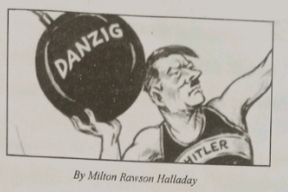
Which incident depicted in the above cartoon led to the beginning of the Second World War?
View Solution
The cartoon illustrates Hitler's aggression towards Danzig, a key issue that led to the outbreak of World War II. The invasion of Poland on September 1, 1939, was the immediate cause of the Second World War. In response, Britain and France declared war on Germany, marking the official start of the conflict.
Other options are incorrect because:
- Hitler’s policy of Imperialism (A) was a broader strategy, but the war was triggered by a specific invasion.
- The annexation of Austria (C) (Anschluss, 1938) was an earlier event that did not directly lead to war.
- The attack on Czechoslovakia (D) (1939) was significant but did not result in an immediate global war. Quick Tip: The invasion of Poland in 1939 was the immediate cause of World War II, leading Britain and France to declare war on Germany.
Question 2
Question i:
Mention any two writs issued by the High Court.
View Solution
The High Court, under Article 226 of the Indian Constitution, has the power to issue writs for the enforcement of fundamental rights and other legal rights. Two important writs issued by the High Court are:
1. Habeas Corpus – This writ is issued to produce a person who has been detained illegally before the court.
2. Mandamus – This writ directs a public official or authority to perform a duty they have failed to fulfill. Quick Tip: The five types of writs in India are \textbf{Habeas Corpus, Mandamus, Prohibition, Certiorari, and Quo Warranto}.
Imagine you are an Indian ruler who has signed the Subsidiary Alliance. Mention any two conditions of this agreement which will affect you.
2. The ruler could not form alliances with other powers without British approval.
View Solution
The Subsidiary Alliance, introduced by Lord Wellesley, was a policy to expand British control over Indian princely states. Two major conditions that affected Indian rulers were:
1. The ruler had to accept a British military force within their territory, which they had to finance.
2. The ruler was forbidden from making treaties or alliances with any other power without British consent. Quick Tip: The \textbf{Subsidiary Alliance} led to indirect British rule over Indian states, weakening their independence.
Mention any two causes of the Quit India Movement.
2. British exploitation of Indian resources during World War II.
View Solution
The Quit India Movement (1942), launched by Mahatma Gandhi, aimed at ending British rule in India. Two significant causes were:
1. Failure of the Cripps Mission (1942): The British government offered limited self-government, which was rejected by Indian leaders.
2. British exploitation during World War II: India was dragged into World War II without Indian consent, leading to severe economic and political distress. Quick Tip: The Quit India Movement was one of the final mass movements against British rule, leading to eventual independence in 1947.
Question iv:
In which year did the Surat Split happen? What was the result of this split?
View Solution
The Surat Split occurred in the year 1907 during the Indian National Congress session. The primary outcome was the division of Congress into:
1. Moderates (led by Gopal Krishna Gokhale), who believed in constitutional methods of reform.
2. Extremists (led by Bal Gangadhar Tilak), who advocated mass agitation and self-rule.
This split weakened the national movement temporarily, allowing the British to adopt a divide-and-rule policy. Quick Tip: The \textbf{Surat Split} was a significant event in the Indian freedom movement, delaying the struggle for independence.
Mention any two common ideologies of Fascism and Nazism.
View Solution
Both Fascism (in Italy) and Nazism (in Germany) shared key ideological principles:
1. Extreme Nationalism: They promoted the superiority of their own nation and culture while suppressing others.
2. Dictatorial Leadership: Both systems were led by powerful autocratic rulers—Benito Mussolini in Italy and Adolf Hitler in Germany. Quick Tip: Fascism and Nazism were totalitarian ideologies that led to World War II and mass human rights violations.
Name the two cities of Japan which were bombed by America in the year 1945.
View Solution
During World War II, the United States dropped atomic bombs on:
1. Hiroshima (August 6, 1945)
2. Nagasaki (August 9, 1945)
These bombings led to mass destruction and forced Japan to surrender, marking the end of World War II. Quick Tip: The bombings of Hiroshima and Nagasaki were the first and only use of nuclear weapons in war, changing global warfare forever.
Read the given news carefully and answer the question that follows:
Govt’s power to promulgate, repromulgate Ordinances — why and how
An Ordinance “shall have the same force and effect as an Act of Parliament”. But the government is required to bring an Ordinance before Parliament for ratification — and failure to do so will lead to its lapsing “at the expiration of six weeks from the reassembly of Parliament”.
The Indian Express – May 25, 2023
Mention any two points regarding an ordinance that can be deduced from the above news.
View Solution
The power to promulgate Ordinances is granted to the President under Article 123 of the Indian Constitution. Based on the given news, two key points about Ordinances can be deduced:
1. Ordinances have the same force as an Act of Parliament – This means they are temporary laws that can be enacted without parliamentary approval initially.
2. Ordinances must be ratified by Parliament – They must be presented before Parliament when it reassembles and must be approved within six weeks, failing which they lapse automatically. Quick Tip: An \textbf{Ordinance} is a temporary law passed by the President when Parliament is not in session, but it must be ratified within six weeks of reassembly.
Question 3
Question i:
The Rajya Sabha is called a Permanent House. Explain this statement.
View Solution
The Rajya Sabha is called a Permanent House because it is never completely dissolved. Unlike the Lok Sabha, which is dissolved every five years, the Rajya Sabha follows a system of staggered elections, where:
- One-third of its members retire every two years, and new members are elected to replace them.
- This ensures that the Rajya Sabha continues to function without facing dissolution at any point. Quick Tip: The Rajya Sabha provides continuity in the Parliament as it is a permanent house, with one-third of its members retiring every two years.
Explain the composition of the Rajya Sabha.
View Solution
The Rajya Sabha, or the Council of States, is the upper house of the Indian Parliament. Its composition is as follows:
- The maximum strength of the Rajya Sabha is 250 members.
- Out of these, 238 members are elected by the Legislative Assemblies of States and Union Territories.
- The remaining 12 members are nominated by the President of India for their expertise in fields such as literature, science, art, and social service. Quick Tip: The Rajya Sabha represents the states of India and plays a crucial role in law-making, acting as a revising chamber.
Mention any two exclusive powers of the Lok Sabha and \textit{two powers \textit{exclusive to the Rajya Sabha.
View Solution
The Lok Sabha and Rajya Sabha have some powers that are exclusive to them:
Exclusive Powers of Lok Sabha:
1. Money Bills can only be introduced in the Lok Sabha, and the Rajya Sabha can only suggest amendments but cannot reject them.
2. The Lok Sabha alone has the power to pass a No-Confidence Motion against the Council of Ministers, leading to the resignation of the government.
Exclusive Powers of Rajya Sabha:
1. Under Article 249, the Rajya Sabha can pass a resolution (by a two-thirds majority) allowing Parliament to legislate on a subject in the State List.
2. Under Article 312, the Rajya Sabha can approve the creation of new All-India Services, such as the IAS and IPS. Quick Tip: While the Lok Sabha has financial supremacy, the Rajya Sabha plays a crucial role in state representation and constitutional amendments.
Question 4
Question i:
Mention any three points to distinguish between the Council of Ministers and the Cabinet.
View Solution
The Council of Ministers and the Cabinet are two distinct entities in the Indian government. The key differences are:
1. Composition:
- The Council of Ministers includes all three levels—Cabinet Ministers, Ministers of State, and Deputy Ministers.
- The Cabinet consists of only senior ministers who make major decisions.
2. Role:
- The Cabinet is the policy-making body of the government.
- The Council of Ministers is responsible for assisting in administration at various levels.
3. Meetings:
- The Cabinet meets regularly to take key decisions.
- The Council of Ministers as a whole rarely meets and follows Cabinet decisions. Quick Tip: The Cabinet is the core decision-making body of the government, while the Council of Ministers includes all levels of ministers.
Who appoints the Cabinet Ministers? Mention any two administrative powers of the Cabinet.
View Solution
The Cabinet Ministers are appointed by the President of India based on the recommendation of the Prime Minister.
Two important administrative powers of the Cabinet are:
1. Policy Implementation: The Cabinet formulates and executes policies related to governance, defense, economy, and social welfare.
2. Supervision of Ministries: The Cabinet oversees and coordinates the work of different ministries to ensure smooth administration. Quick Tip: The Cabinet plays a crucial role in policymaking, and its ministers are appointed by the President on the advice of the Prime Minister.
The President is the nominal head of the Indian Union. Mention \textit{any four functions of the Prime Minister with reference to the President.
View Solution
The Prime Minister is the real executive authority of the country, while the President acts as the nominal head. The functions of the Prime Minister concerning the President include:
1. Advisor to the President: The Prime Minister advises the President on major decisions, including the appointment of ministers and key officials.
2. Head of the Government: The Prime Minister leads the government, formulates policies, and ensures their implementation.
3. Cabinet Coordinator: The Prime Minister serves as a link between the President and the Cabinet, communicating Cabinet decisions to the President.
4. International Representation: The Prime Minister represents India at global forums, negotiations, and summits. Quick Tip: The Prime Minister is the real head of the government, whereas the President acts on their advice in most matters.
Question 5
Question i:
What is the composition of the Supreme Court? Why is it called the Court of Record?
View Solution
The Supreme Court of India consists of:
- 34 judges, including the Chief Justice of India (CJI).
- Judges are appointed by the President of India based on the collegium system.
The Supreme Court is known as a Court of Record because:
1. Its judgments are recorded and serve as binding precedents for lower courts.
2. It has the power to punish for contempt of court. Quick Tip: The Supreme Court's decisions are binding on all lower courts, making it a \textbf{Court of Record}.
Explain the power of Judicial Review.
View Solution
The power of Judicial Review enables the Supreme Court to:
1. Determine whether laws and executive actions violate the Constitution.
2. Strike down unconstitutional laws and protect fundamental rights. Quick Tip: Judicial Review ensures that laws passed by Parliament adhere to the Constitution.
What is meant by the term Original Jurisdiction? Mention \textit{any three cases which come under this jurisdiction.
View Solution
The Original Jurisdiction of the Supreme Court refers to cases that can be directly filed in the Supreme Court without being heard by lower courts first. Under Article 131 of the Indian Constitution, the Supreme Court has exclusive Original Jurisdiction in the following cases:
1. Disputes between the Centre and States: Any legal conflict between the Government of India and one or more States falls under Original Jurisdiction.
2. Inter-State Disputes: When two or more States have disagreements (e.g., river water-sharing disputes), the Supreme Court has exclusive authority to resolve them.
3. Enforcement of Fundamental Rights: Under Article 32, individuals can directly approach the Supreme Court to seek protection of their Fundamental Rights. Quick Tip: The Supreme Court’s Original Jurisdiction allows it to directly hear disputes involving States and the Central Government, ensuring federal balance.
Question 6
Question i:
Mention any three changes made in the administration with the end of the Company’s Rule.
View Solution
After the Revolt of 1857, significant administrative changes were made:
1. End of Company Rule: The British government abolished the rule of the East India Company, and India was placed under direct British Crown rule through the Government of India Act, 1858.
2. Introduction of the Viceroy: The title of the Governor-General was changed to Viceroy of India, who was the direct representative of the British Crown.
3. Reorganization of Civil Services: The British introduced the Indian Civil Services (ICS) to strengthen administrative control over India. Quick Tip: The Revolt of 1857 led to the end of Company rule and brought India under direct British control.
State any three policies promised to Indians in Queen Victoria’s Proclamation.
View Solution
Queen Victoria’s Proclamation was issued in 1858 after the Revolt of 1857, marking the transfer of power from the East India Company to the British Crown.
Three policies promised to Indians in the Proclamation:
1. Equal Treatment: The British Crown assured that Indians would be treated equally before the law, just like British citizens.
2. Religious Non-Interference: The proclamation guaranteed non-interference in Indian religious and social practices, addressing fears of forced religious conversions.
3. Protection of Land Rights: The government promised not to take away land from Indians unjustly and ensured the protection of property rights. Quick Tip: Queen Victoria’s Proclamation aimed to pacify Indians after the Revolt of 1857 by assuring fair governance under British rule.
Mention any four changes made in the army after the Revolt.
View Solution
After the Revolt of 1857, the British made several major changes in the Indian army to prevent future uprisings.
Four changes made in the army after the Revolt:
1. Increased British Troops: The ratio of British to Indian soldiers was increased from 1:5 to 1:2, reducing Indian dominance in the army.
2. Disarmament of Indian Soldiers: Indian soldiers were restricted from handling artillery and advanced weapons.
3. Divide and Rule in Recruitment: The British recruited from "martial races" like Punjabis and Gurkhas while reducing recruitment from Bengalis and Marathas, who were active in the revolt.
4. British Control Over Officers: High-ranking military positions were reserved only for British officers, ensuring full British command over Indian troops. Quick Tip: After 1857, the British structured the Indian army to prevent unity among Indian soldiers and reduce the chances of rebellion.
Question 7
Question i:
Who partitioned Bengal? Mention \textit{any two points to explain the perspective of the Nationalists regarding the \textit{actual motive behind the decision of Partition.
View Solution
The Partition of Bengal was carried out by Lord Curzon in 1905 under the pretext of administrative efficiency. However, the Indian Nationalists strongly opposed it, arguing:
1. Divide and Rule Policy: Nationalists believed that the real motive was to divide Hindus and Muslims by creating East Bengal (Muslim-majority) and West Bengal (Hindu-majority).
2. Weakening Nationalist Movement: Bengal was the center of Indian nationalism, and partition aimed to break the unity of nationalists in the region. Quick Tip: The Partition of Bengal led to the Swadeshi Movement and widespread protests, forcing the British to annul it in 1911.
What was the objective of the \textit{Assertive Nationalists? Mention \textit{any two contributions of Bal Gangadhar Tilak.
View Solution
The Assertive Nationalists, led by Bal Gangadhar Tilak, Bipin Chandra Pal, and Lala Lajpat Rai, believed in aggressive protests, boycotts, and Swadeshi movements to gain self-rule.
Two contributions of Bal Gangadhar Tilak:
1. Swaraj Movement: He popularized the slogan "Swaraj is my birthright and I shall have it", inspiring Indians to fight for independence.
2. Cultural Nationalism: Tilak started Ganesh Utsav and Shivaji Jayanti to bring Hindus together and create a sense of nationalism against British rule. Quick Tip: Bal Gangadhar Tilak was called the \textbf{Father of Indian Unrest} because of his aggressive nationalism.
In which year was the Muslim League formed? Mention \textit{any three objectives of the Muslim League.
View Solution
The Muslim League was formed on December 30, 1906, in Dhaka under the leadership of Nawab Salimullah and Aga Khan.
Three objectives of the Muslim League:
1. Loyalty to the British: The League aimed to maintain loyalty to the British Government and secure favors for the Muslim community.
2. Protection of Muslim Interests: The League worked to protect the rights of Muslims in India, especially in politics and education.
3. Prevention of Hindu Dominance: It sought to ensure that Muslims had a separate political identity and were not overshadowed by the Hindu-majority Congress. Quick Tip: The Muslim League later played a key role in the demand for Pakistan and the partition of India in 1947.
Question 8
Question i:
Name the Viceroy who announced the plan for smooth transfer of power. Mention \textit{any two clauses of his plan with reference to the Princely States.
View Solution
The Viceroy who announced the plan for the smooth transfer of power was Lord Mountbatten. His plan, known as the Mountbatten Plan (June 3, 1947), laid the foundation for India's partition and independence.
Two clauses related to the Princely States:
1. Right to Join India or Pakistan: The princely states were given the choice to join either India or Pakistan or remain independent.
2. End of British Paramountcy: The British government would no longer interfere in the affairs of the princely states after independence, leaving their fate to their rulers. Quick Tip: The Mountbatten Plan led to the partition of India and Pakistan, allowing princely states to decide their future.
Mention any three reasons for the acceptance of his plan by the Congress.
View Solution
The Congress accepted the Mountbatten Plan due to the following reasons:
1. Communal Riots and Violence: Widespread communal riots between Hindus and Muslims made partition seem like the only way to restore peace.
2. End of British Rule: The plan promised a definite date for India's independence (August 15, 1947), which was a priority for Congress.
3. Control Over Key Territories: The plan ensured that major Hindu-majority regions, including most princely states, would be part of India. Quick Tip: Congress accepted the Mountbatten Plan to secure independence quickly and prevent further communal violence.
Mention any four provisions of the \textit{Indian Independence Act of 1947.
View Solution
The Indian Independence Act of 1947 was passed by the British Parliament to grant independence to India and Pakistan.
Four key provisions of the Act:
1. Creation of Two Nations: India and Pakistan were declared as two separate independent dominions.
2. End of British Rule: The British Crown’s paramountcy over India ended, and the new governments gained full sovereignty.
3. Partition of Provinces: Provinces like Punjab and Bengal were divided between India and Pakistan based on religious demographics.
4. Governor-General for Each Dominion: India and Pakistan would each have a Governor-General, appointed by the British King until a new government was fully formed. Quick Tip: The Indian Independence Act of 1947 marked the legal end of British rule and the partition of India and Pakistan.
Question 9
Question i:
Mention any three causes of the World War which ended with the signing of the treaty being discussed in the passage above.
View Solution
The passage refers to the Treaty of Versailles (1919), which officially ended World War I.
Three causes of World War I:
1. Militarism: European nations built large armies and stockpiled weapons, leading to an arms race.
2. Alliance System: Countries formed military alliances (Triple Entente and Triple Alliance), increasing tensions.
3. Assassination of Archduke Franz Ferdinand: The murder of the Austrian heir in 1914 triggered a chain reaction leading to war. Quick Tip: World War I (1914-1918) was mainly caused by nationalism, militarism, imperial rivalries, and complex alliances.
Name the organization which was established in 1920 to maintain peace after this war. Mention \textit{any two of its objectives.
View Solution
The organization established in 1920 to maintain peace after World War I was the League of Nations. It was formed as part of the Treaty of Versailles to prevent future conflicts.
Two objectives of the League of Nations:
1. Prevent Wars: The League aimed to promote international cooperation and resolve disputes peacefully.
2. Disarmament: It encouraged member nations to reduce their military forces to avoid another global war. Quick Tip: The League of Nations failed to prevent World War II, leading to its replacement by the United Nations in 1945.
Mention any four clauses of the Treaty which affected Germany.
View Solution
The Treaty of Versailles (1919) imposed severe conditions on Germany, leading to economic hardship and resentment.
Four clauses of the treaty that affected Germany:
1. Loss of Territory: Germany lost Alsace-Lorraine to France and had to give up colonies.
2. Disarmament: The German army was limited to 100,000 soldiers, and no submarines or air force were allowed.
3. War Guilt Clause: Germany had to accept full responsibility for World War I and its damages.
4. Reparations: Germany was required to pay heavy reparations (132 billion gold marks) to the Allied nations. Quick Tip: The harsh conditions of the Treaty of Versailles contributed to the rise of Hitler and the outbreak of World War II.
Question 10
Question i:
Mention any three functions of the Security Council.
View Solution
The United Nations Security Council (UNSC) is responsible for maintaining international peace and security.
Three functions of the Security Council:
1. Maintaining International Peace: The UNSC takes measures to prevent conflicts and authorizes peacekeeping missions.
2. Sanctions and Military Actions: It imposes economic sanctions and authorizes military action against aggressor nations if needed.
3. Admission of New Members: The Security Council recommends new member states for admission to the United Nations. Quick Tip: The UNSC has five permanent members with veto power: USA, UK, Russia, China, and France.
Mention any three functions of the World Health Organization.
View Solution
The World Health Organization (WHO) is a specialized agency of the UN that works on global health issues.
Three functions of the WHO:
1. Disease Control and Eradication: WHO plays a key role in eradicating diseases like polio and malaria through vaccination programs.
2. Health Research and Guidance: It conducts research on diseases and provides international guidelines for public health.
3. Emergency Response: WHO responds to global health emergencies, such as pandemics, by coordinating international efforts. Quick Tip: The WHO declared COVID-19 a global pandemic in 2020 and coordinated global response efforts.
Name any two founders of the Non-Aligned Movement. Mention \textit{any two of its objectives.
View Solution
The Non-Aligned Movement (NAM) was founded during the Cold War to promote neutrality and independence from military alliances.
Two founders of the Non-Aligned Movement:
1. Jawaharlal Nehru (India)
2. Josip Broz Tito (Yugoslavia)
Two objectives of the Non-Aligned Movement:
1. Promoting World Peace: NAM aimed to maintain peace by avoiding alliances with military blocs like NATO and the Soviet Union.
2. Economic Development: It focused on the economic and social progress of developing nations by promoting cooperation. Quick Tip: The Non-Aligned Movement was officially formed in 1961 at the Belgrade Conference.
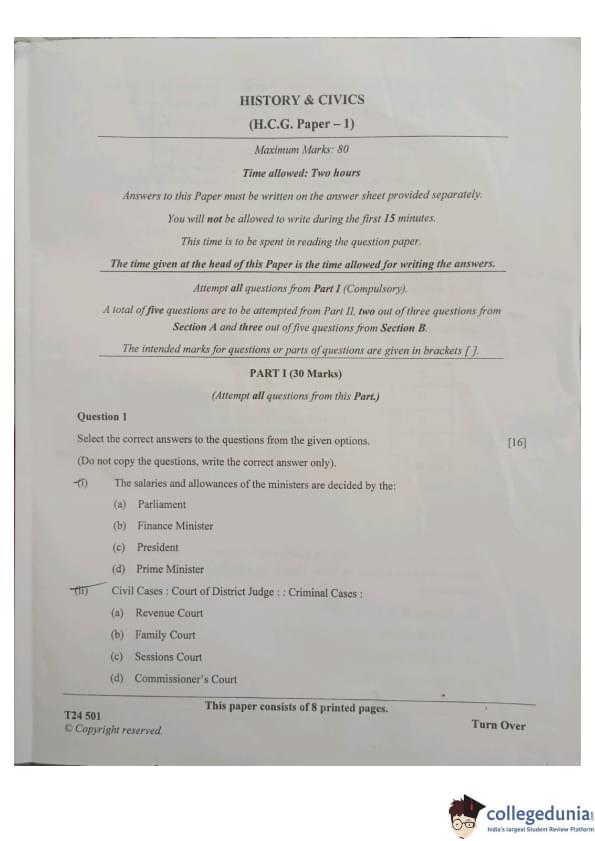



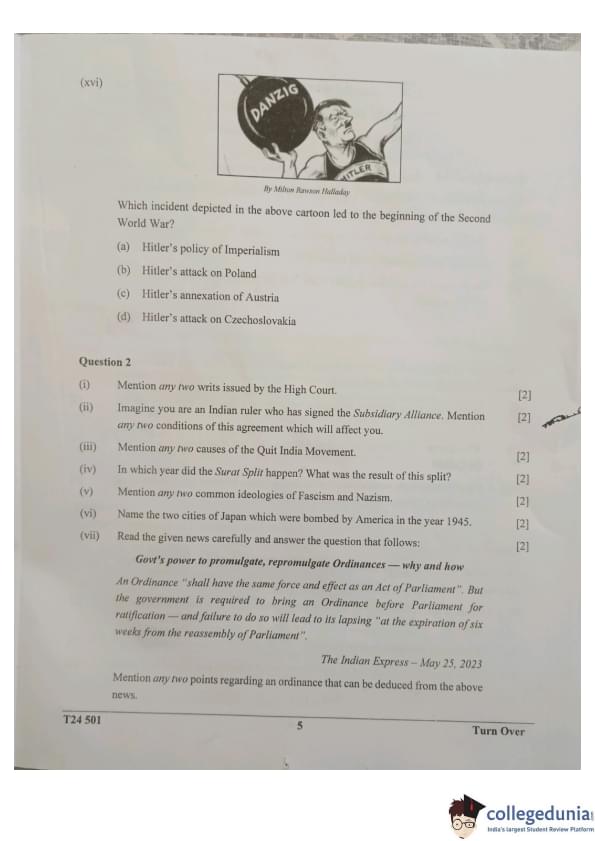
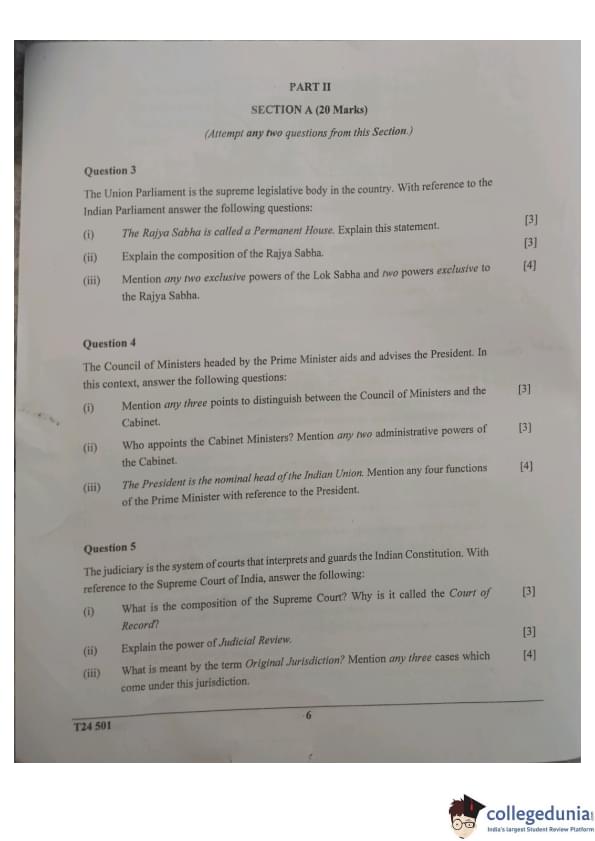
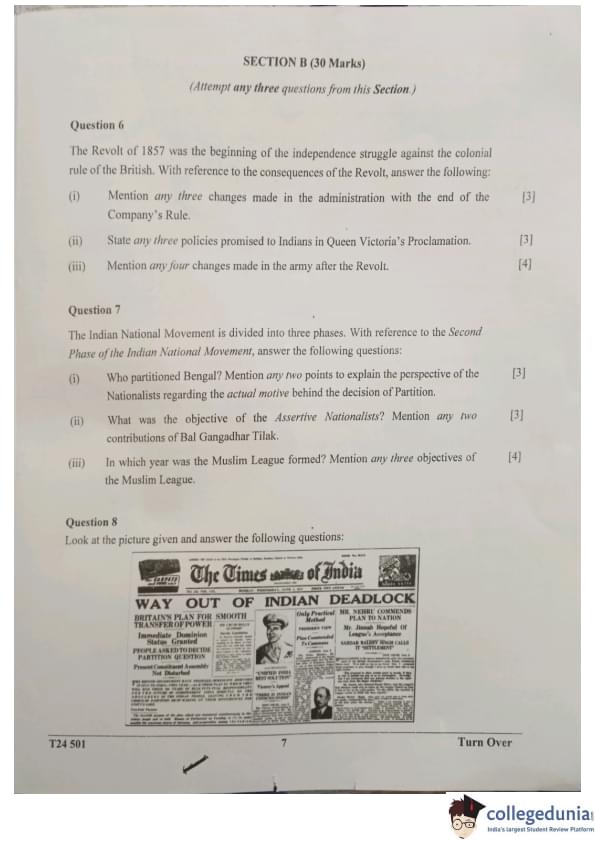
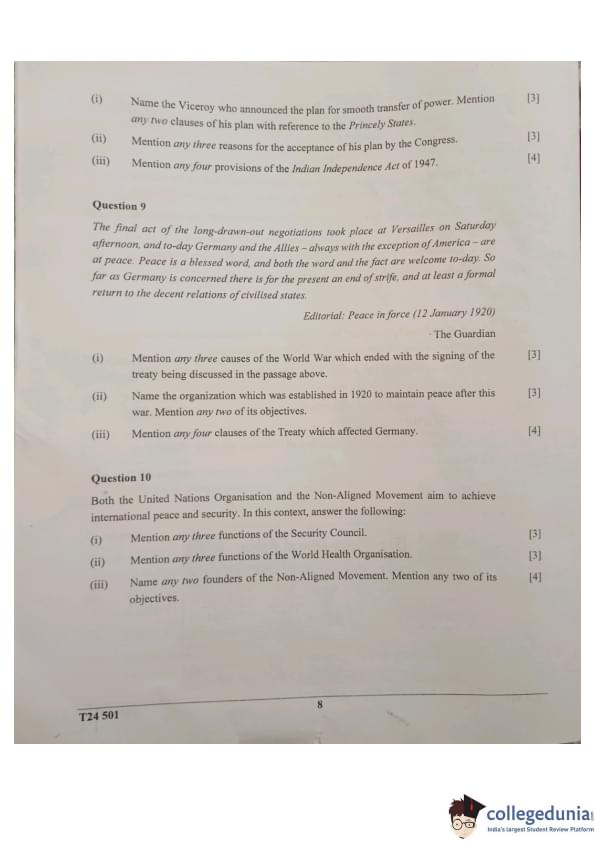



Comments